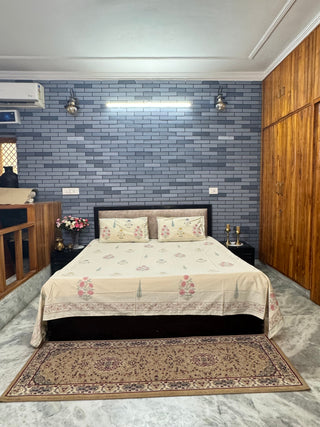Kalamkari, an ancient Indian art form, that has captivated the world with its intricate hand-painted designs and vibrant storytelling. The name "Kalamkari" is derived from two words: 'kalam' meaning pen and 'kari' meaning craftsmanship, reflecting the essence of this traditional art.
In this article, we delve into the history, techniques, and cultural significance of the Kalamkari print.
History and Origins:
Kalamkari traces its roots to ancient India, with evidence suggesting its existence as far back as the 6th and 7th centuries. This intricate art form flourished in various regions, with notable centres in Andhra Pradesh and Telangana. The art of Kalamkari evolved over centuries, influenced by Persian, Mughal, and European styles, resulting in a unique fusion of cultural influences.
Two Distinct Styles:
- Srikalahasti Style: This style of Kalamkari is known for its intricate pen-drawn freehand designs. Artists use a pointed bamboo or date palm stick, filled with natural dyes, to meticulously draw detailed motifs and mythological narratives. The themes often revolve around Hindu epics, folklore, and nature.
- Machilipatnam Style: Also known as the "block-printed Kalamkari," this style involves using hand-carved wooden blocks to print designs on fabric. Artisans then use a pen to fill in the finer details and add nuances to the printed patterns. This style often incorporates Persian and Mughal influences in its designs.
The Kalamkari Print Process:
- Preparation of Fabric: Kalamkari traditionally uses natural fabrics like cotton or silk. The fabric undergoes a meticulous cleaning and treatment process to ensure it absorbs the dyes and retains the vibrancy of the colours.
- Mordant Application: The fabric is treated with a mordant, usually a mixture of milk and buffalo dung, to enhance the adherence of natural dyes. This step prepares the fabric for the intricate painting process.
- Outlining with Kalam: In the Srikalahasti style, artists use a kalam (pen) to draw fine outlines of the design on the fabric. The kalam is typically made from bamboo or date palm, and the artist's skill lies in controlling the flow of dye to create precise lines.
- Dyeing and Filling Colors: The outlined fabric is then dipped into natural dye baths. Each colour is filled in separately, and the fabric is dried between each dyeing stage. The process is repeated until the desired colour palette is achieved.
- Adding Details: In both styles, additional details and shading are added with the kalam, creating depth and dimension in the artwork. This meticulous process requires a high level of skill and patience.
- Washing and Finishing: Once the painting is complete, the fabric is washed to remove excess dye and mordant. The final result is a stunning piece of hand-painted textile, rich in colour and cultural narratives.
Cultural Significance:
Kalamkari print goes beyond its aesthetic appeal; it is a cultural repository that tells stories of mythology, tradition, and spirituality. The intricate designs often depict scenes from Hindu epics like the Ramayana and Mahabharata, showcasing the rich cultural heritage of India.
Contemporary Adaptations:
In the modern era, Kalamkari has found a place in the global fashion and design scene. Designers are incorporating Kalamkari prints into clothing, accessories, and home decor, preserving the traditional art while giving it a contemporary twist. This has not only sustained the craft but has also introduced it to a wider audience.
Kalamkari print stands as a testament to the enduring beauty of traditional Indian art. Its rich history, intricate techniques, and cultural significance make it a cherished craft. As we celebrate the legacy of Kalamkari, it continues to bridge the gap between the past and the present, showcasing the timeless appeal of handcrafted artistry.

